Theme Parks & Themed Entertainment
Katy Harris talks about all the hard work that went into creating Disneyland Paris’ new holiday offerings

After beginning her theatrical career dancing in London’s West End and then traveling the world, Katy Harris found herself at what was
then known as EuroDisney working as a dancer at that theme park’s “Beauty
and the Beast” stage show. From there, Harris quickly rose through the
ranks and help produce Walt Disney Studios seasonal events such as Kids
Carnival and DLP’s 15th anniversary “Once Upon a Dream Parade.”
Over the past few years, Katy has worked hand-in-hand with Walt Disney
Imagineering on the creation of Disneyland Paris’ 20th nighttime spectacular,
“Disney DREAMS” and this year’s “Disney DREAMS Fete Noel /
Disney DREAMS of Christmas” show as well as DLP’s new tree lighting
ceremony, “Magical Christmas Wishes.”
Let’s look into how Harris and her team creates magic at the
Disneyland Paris Resort.
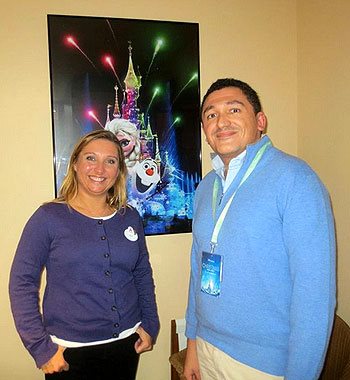
Katy Harris & Andrea
Monti at the “Disney DREAMS Fete
Noel / Disney DREAM of Christmas” press
event
AM: Yours is a classic Disney success story; rising up
through the ranks to then becoming show director. How does it feel to look
back?
KH: How does it feel? It feels like I am living a dream. I
started dancing on a stage in 1993 on the “Beauty and the Beast” show & at the
Lucky Nugget and then — over time — moved on to direct shows both small and
big, parades and nighttime spectaculars. When I meet people I used to dance with or used to know
years ago, it always strikes me how much has happened and how fast it all
happened.
AM: What do you consider your highlights?
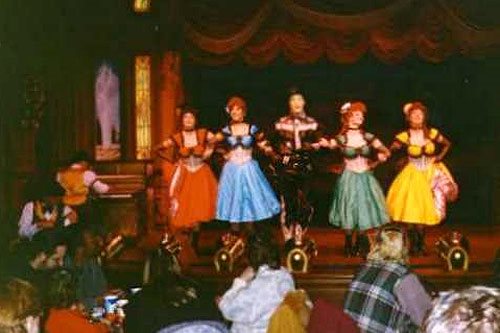
EuroDisneyland’s Lucky
Nugget Revue (1992 – 1993)
KH: It would be easy to say the latest shows our team (And I
say ‘team’ because projects like these always involve teamwork and I have been
lucky to work with amazing teams) has
worked on. I’m especially proud of the new Christmas tree ceremony
“Magical Christmas Wishes” and believe that the new “Disney DREAMS Of Christmas”
nighttime show is a really wonderful way for our guests to celebrate the
holiday season in the park.
Of course, if I was to look back, I could not forget how
wonderful it was to work on the 15th anniversary parade, “Disney’s Once Upon a
Dream Parade” in 2007, the months that I spent in Hong Kong Disneyland back in 2008
were great fun and different from my Paris
agenda and — of course — there is that
time I created the “Celebrate the Magic“
show on the Magic Kingdom‘s
Cinderella Castle
in Orlando.
The first night I started rehearsing with my team at 2 a.m. in the Orlando
projecting on Cinderella Castle
was a moment I won’t easily forget. Nearly alone in the Magic Kingdom playing projections on that iconic castle. Wow,
a dream come true!
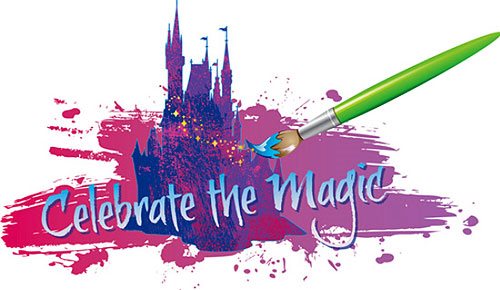
Copyright Disney
Enterprises, Inc. All rights reserved
AM: What would you like everyone, Disney fans, theme park geeks and first time
guests to see in your works?
KH: Heart. Putting layers of emotions and content that will
be interpreted differently by each guest. Sometimes there’s this preconception about theme
park shows, that they’re all about spectacle and shallow. My team and I try to create
layers of elements and story that everyone can relate to. I like to add emotional,
heartwarming moments and make everyone smile. My goal is to create something that
our guests will want to come back and see again and share with their friends and
family. That was especially what we were going for in the new “Christmas Wishes”
tree lighting ceremony.
AM: You have also worked in Hong Kong
for the Olympic year, creating a kinetic show in the castle forecourt. That was certainly a change of
pace. What did you bring back to Paris
from that experience?
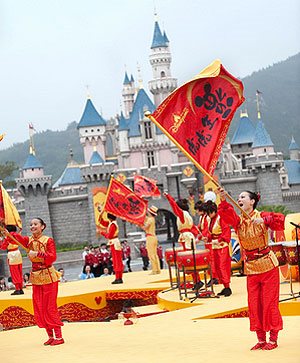
Acrobats performing in front
of Sleeping Beauty
Castle at Hong Kong Disneyland
KH: My time in Hong Kong allowed me
to discover a different cast and a different audience, also multilingual
(English, Mandarin & Cantonese), very different but still very, very eager for all things Disney. I worked on the 2008 show which
played 5 times a day in front of Sleeping
Beauty Castle.
It was a fun-filled energetic acrobatic extravaganza with dancers and the
characters holding their own Olympic sporting events. Goofy was a weight
lifter, Minnie was a gymnast and Chip & Dale played volleyball. Children
were invited to participate in all of the fun too. We even gave engraved
limited-edition gold medals to the children of the different games we did.
Those medals today have become a collectible as they have the inscription if
not only HKDL but also the date of the 2008 Olympics.
AM: Did it help later in the energy-driven “High School
Musical” street show?
KH: “High School Musical
” became an instant hit in the Walt Disney
Studios theme park. We were lucky enough to go to California
to learn all the dance moves. Guests might not have realized it but we were
able to incorporate most of the dance moves from the Disney Channel film into
the Walt Disney Studios show. And — yes — our Paris
cast was as energetic as the Disney Channel cast.
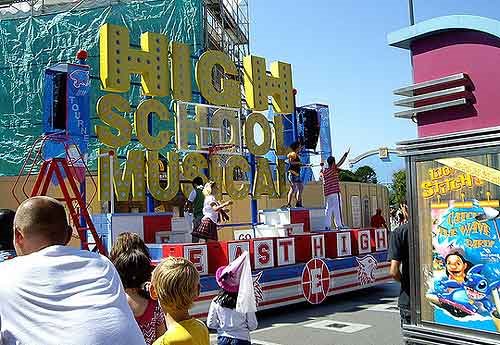
The “High School
Musical” rolling stage at Wat Disney Studios theme park.
AM: You went from big parades in 2007 for Disneyland Paris’
15th anniversary to smaller events in 2008 & 2009 and then back again to
huge DREAMS. And the size of the audiences for each of these presentations
varied from 30,000 people watching a parade to 2000 people enjoying something
relatively intimate like a “High School Musical” street show to
70,000 people watching a show like “Disney DREAMS.” When you works on
shows that have such different scales as these, how do you keep the level of heart?
KH: By staying true to that little English girl inside of me
who — when she was small back home — always,
always, always wanted to dance for Mickey I guess (Laughter). Jokes aside, I’m glad that people recognize the heart which
goes into these shows. Most of our rehearsals are done at night. For example, “Disney
DREAMS Fete Noel” had 7 weeks of night-only rehearsals. You simply cannot get into all that work if you don’t
believe in it with passion and know what you want from it. And what I want, what I wish, is
for the guests to leave from the show smiling and feeling as though they have shared
a uniquely wonderful journey.
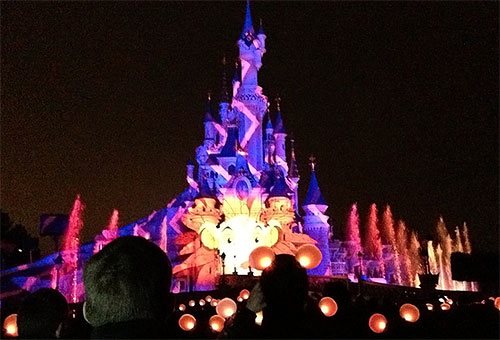
An audience equipped with
“Glow with the Show” ears watches “Disney DREAMS”
AM: I therefore need to ask you: What does Katy Harris smile
more at?
Seeing the full audience of “DREAMS” lighting up with their “Glow with the
Show” ears hats on?
- Seeing a 4 year-old girl dressed as Snow White cry when her
princess bows and knees down at her in the Princess pavilion?
- Mickey posing with a family?
- Or the simple wave of hand and blowing a kiss back of a
Princess from a float to a girl?
KH: I look at the eyes of the guests. The eyes often tell
more than the smile. Looking around when a show is on, I tend to look at where people
focus their attention. How they react, what they prefer and how they see everything.
Especially for repeat guests, it’s nice to know what they like about the show
that makes them come back.

Copyright Disney Enterprises,
Inc.
All rights reserved
AM: After “DREAMS” you took charge with a small &
energetic team and then transformed the Magic
Kingdom’s previous castle
projection show, “The Magic, The Memories and You” to “Celebrate
the Magic.” Can we expect to see more of your work in Orlando?
KH: “Celebrate the Magic” came straight after “DREAMS.”
It was conceived from the start as a retooling of the previous show, “The
Magic, the Memories, and You.” But that project soon took on its own
spirit & energy. I was especially pleased to slip a few vintage Disney tributes
into that show, such as Walt hand-drawing Mickey and Mickey in his red shorts
coming out (something we rarely use in Paris).
The show was deliberately conceived so that new segments could easily be added
to “Celebrate the Magic.” Which is why — to date — we’ve added Summer
scenes, Halloween scenes, Christmas scenes and now even a scene from Disney
“Frozen” which will be based on that animated film’s amazingly
powerful new song, “Let It Go.” Which we just used here in Paris
as part of our “Disney DREAMS of Christmas” shows. That new scene is
opening as part of Walt Disney World’s castle projection show on November 18th.
And I’m flying to Orlando tomorrow
morning (Sunday, November 10th) right after we debut all of DLP’s new holiday
offerings late tonight.
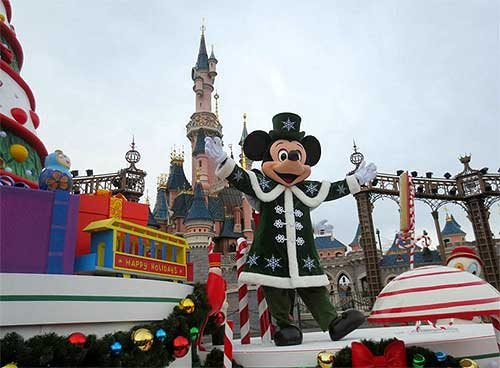
Photo by Andrea Monti
AM: Speaking of which: DLP has a tradition of creating many
new seasonal events, second only to Tokyo Disneyland. Paris
has always considered Christmas to be one of a high point
of its year. What does your new take on Xmas-at-DLP bring to this tradition?
KH: This year, we are debuting a brand-new Christmas tree at
the Park (The previous tree was the original one from the 1992 park opening
Xmas season) and we have an amazing new LED light system to go with it. Technology,
though, is never enough at Disney. And as much as our team developed a
state-of-the-art, unique-to-Disneyland-Paris light system, we wrap it all
around STORY. Here the story is about sharing the wishes of children under the
Christmas tree, a subtle and intimate message that will hopefully play into the
hearts of everyone whatever their age is.
With our team, we decided to make a show which, unlike previous versions of the
Christmas tree lighting ceremony for Disneyland Paris, could be seen from all
around Town Square and even
down Main Street through to
Central Plaza.
A show without floats and characters but driven by the narrating voices of Jiminy
Cricket (in English) and Pinocchio
(in French). Which would then help
children-of-all-ages remember the joy of gathering with their families around a
lit-up Christmas tree and all the warmth & joy that the holiday season
brings.
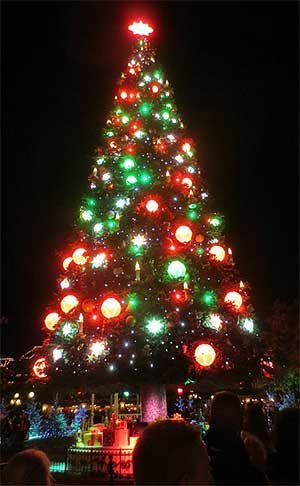
Photo by Andrea Monti
Hopefully this “Magical Christmas Wishes” tree
lighting ceremony will become an Xmas classic just like the “Believe in
Holiday Magic” fireworks show at Disneyland
or how the Osborne Lights at Disney’s Hollywood Studios have become holiday traditions in the States.
We tried to make something for all and placed a lot of love in all those nights
developing the tree and its story. I look forward to seeing the faces of our
guests when it begins to snow on them. Now onto “Disney DREAMS Of
Christmas”
AM: When this new holiday show was first announced, everyone
believed that it would just be a tag, a new holiday-themed scenes that would
then be added to the existing “DREAMS.” Instead DLP wound up with a
whole new show. How long did it take to create this from start to finish?
KH: Steve Davison back in California
has created this concept which would be shared by World of Color and our
Castle. Both shows were developed and the music is shared. But due to the different venues & guest expectations, we
very quickly started to create two very different versions of the same show. The message
& the spirit of both shows would remain identical, though.
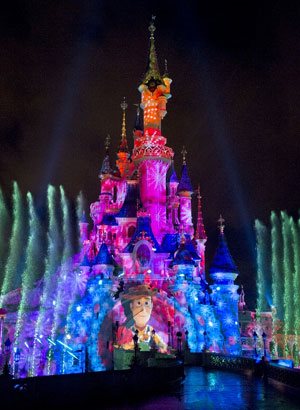
I worked for five weeks in California
this past Summer on the animation and testing of the show on models of the castle. Then I came back to Paris
in September to start a full seven weeks of night-time rehearsals. I acted as Steven’s show director in Paris.
Meaning I followed everything on the Paris show,
making it unique as I directed the show. Guests will see something very
different between the Paris and California
shows. We shared a lot of technology and concepts but then Europeanized it.
Creating specific elements for the architecture of our incredible castle. We
also have fireworks in the Paris
show.
AM: This show has Olaf the Snowman from Disney’s upcoming
“Frozen” acting as narrator, in a role somewhat similar to Peter
Pan’s shadow in the original “DREAMS.” But for the first time ever, Mickey
and Minnie are in this castle projection show. There’s also that classic piece
of animation from “Bambi
” where Thumper teaches the Young Prince to
slide on the ice. And the Green Army Men from “Toy Story
” perform a
wonderful funny tribute to Disney’s “Fantasia
.” Compared to the
original version of “DREAMS,” this castle projection show has more of
a classic feel with more retro material from the Disney vaults. Was this a
deliberate choice?
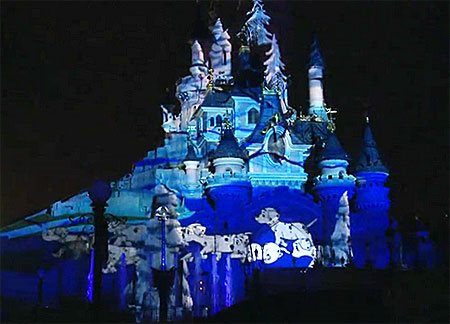
KH: Christmas & Winter are a Disney staple. We all knew
in our hearts that those first images of little Prince Bambi learning to slide on the ice
or the Dalmatians making their escape across the ice had to be part of the
holiday version of “DREAMS.” Likewise those scenes from “Lady
and the Tramp
” which featured Christmas trees. And getting some vintage
Mickey and Minnie up on the castle is a great reminder of al the wonderful short
films that Walt Disney Animation Studios has produced over the years.
AM: The original version of “DREAMS” received two new scenes — “Lion
King
” and “Brave
” replacing “Mary Poppins
” and
“The Jungle Book
.” Can we expect more new scenes to be folded into this
castle projection show in the coming years?
KH: That’s the beauty of these castle projection shows. They
can be changed and improved all the time. A little bit like what Walt used to
say about Disneyland, that it can never be completed as long as there is
still imagination — and projection space, I might add — left in the world and on the castle (Laughter).
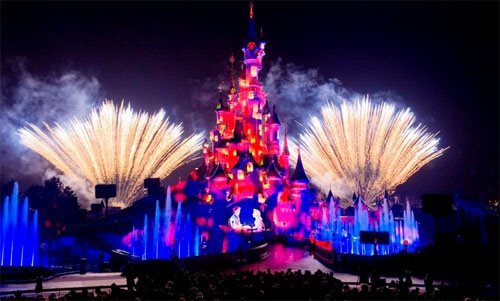
AM: And now for the question that has always been on the DLP
fan forums. Is there any chance of a Halloween version of “DREAMS” ? The
Disney Villains try to take over the castle every night for 3 minutes and 42
seconds. Might they someday get a whole 22 minute-long show for themselves?
KH: Peter Pan and his shadow do manage to keep the Disney
Villains at bay every night. But that is a very interesting series of
characters to explore.
AM: “Disney DREAMS Fete Noel / Disney DREAMS of
Christmas” is a sister show to Disney California Adventure’s “World
of Color — Winter Dreams.” How different are these two night-time shows?
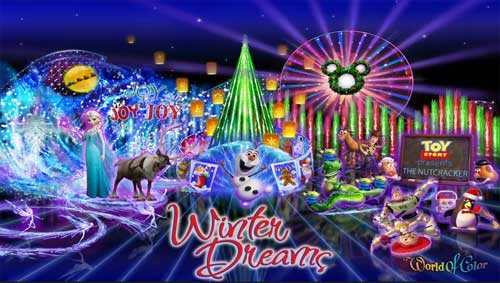
Copyright Disney
Enterprises, Inc. All rights reserved
KH: They share the same concept, heart and spirit. And they
do have some scenes — like the “Toy Story Nutcracker” in common. But
the sing-along finale is exclusive to Paris.
AM: Do you anything else that you might like to add to this
interview?
KH: Have fun and enjoy DLP’s new holiday offerings with all
your heart.
Theme Parks & Themed Entertainment
Disney and Macy’s 90-Year Thanksgiving Day Parade Partnership: From Mickey’s First Balloon to Minnie’s Big Debut

Now, folks, if you’re like me, Thanksgiving just wouldn’t be the same without a coffee, a cozy seat, and Macy’s Thanksgiving Day Parade on the TV. And if you’re really like me, you’re watching for one thing: Disney balloons floating down 34th Street. Ever wondered how Mickey, Donald, and soon Minnie Mouse found their way into this beloved New York tradition? Well, grab your popcorn because we’re diving into nearly 90 years of Disney’s partnership with Macy’s.
The Very First Parade and the Early Days of Balloons
The Macy’s Thanksgiving Day Parade goes way back to 1924, but if you can believe it, balloons weren’t part of the festivities until 1927. That first lineup included Felix the Cat, a dragon, and a toy soldier, all towering above the crowds. Back then, Macy’s had a pretty wild idea to end the parade: they would let the balloons drift off into the sky, free as birds. But this wasn’t just Macy’s feeling generous. Each balloon had a message attached, offering a $100 reward (about $1,800 in today’s dollars) for anyone who returned it to the flagship store on 34th Street.
And here’s where it gets interesting. This tradition carried on for a few years, right up until 1932, when Felix the Cat almost took down a plane flying over New York City! Imagine that—you’re flying into LaGuardia, and suddenly, there’s a 60-foot balloon drifting toward your wing. Needless to say, that was the end of Macy’s “fly away” stunt, and from then on, the balloons have stayed firmly grounded after the parade ends.

1934: Mickey Mouse Floats In, and Disney Joins the Parade
It was 1934 when Mickey Mouse finally made his grand debut in the Macy’s parade. Rumor has it Walt Disney himself collaborated with Macy’s on the design, and by today’s standards, that first Mickey balloon was a bit of a rough cut. This early Mickey had a hotdog-shaped body, and those oversized ears gave him a slightly lopsided look. But no one seemed to mind. Mickey was there, larger than life, floating down the streets of New York, and the crowd loved him.
Mickey wasn’t alone that year. He was joined by Pluto, Horace Horsecollar, and even the Big Bad Wolf and Practical Pig from The Three Little Pigs, making it a full Disney lineup for the first time. Back then, Disney wasn’t yet the entertainment powerhouse we know today, so for Walt, getting these characters in the parade meant making a deal. Macy’s required its star logo to be featured on each Disney balloon—a small concession that set the stage for Disney’s long-standing presence in the parade.
Duck Joins and Towers Over Mickey
A year later, in 1935, Macy’s introduced Donald Duck to the lineup, and here’s where things got interesting. Mickey may have been the first Disney character to float through the parade, but Donald made a huge splash—literally. His balloon was an enormous 60 feet tall and 65 feet long, towering over Mickey’s 40-foot frame. Donald quickly became a fan favorite, appearing in the lineup for several years before being retired.
Fast-forward a few decades, and Donald was back for a special appearance in 1984 to celebrate his 50th birthday. Macy’s dug the balloon out of storage, re-inflated it, and sent Donald down 34th Street once again, bringing a bit of nostalgia to the holiday crowd.
A Somber Parade in 2001
Now, one of my most memorable trips to the parade was in 2001, just weeks after the 9/11 attacks. Nancy and I, along with our friends, headed down to New York, and the mood was something I’ll never forget. We watched the start of the parade from Central Park West, but before that, we went to the Museum of Natural History the night before to see the balloons being inflated. They were covered in massive cargo nets, with sandbags holding them down. It’s surreal to see these enormous balloons anchored down before they’re set free.
That year, security was intense, with police lining the streets, and then-Mayor Rudy Giuliani rode on the Big Apple float to roaring applause. People cheered his name, waving and shouting as he passed. It felt like the entire city had turned out to show their resilience. Even amidst all the heightened security and tension, seeing those balloons—brought a bit of joy back to the city.

Balloon Prep: From New Jersey’s MetLife Stadium to California’s D23 Expo
Each year before the parade, Macy’s holds a rehearsal event known as Balloon Fest at MetLife Stadium in New Jersey. This is where handlers get their first crack at guiding the balloons, practicing with their parade masters, and learning the ropes—literally. It’s an entire production unto itself, with dozens of people rehearsing to make sure these enormous inflatables glide smoothly down the streets of New York on parade day.
In 2015, Macy’s took the balloon show on the road, bringing their Buzz Lightyear balloon out to California for the D23 Expo. I was lucky enough to be there, and watching Buzz get inflated piece by piece in the Anaheim Convention Center parking lot was something to behold. Each section was filled with helium in stages, and when they got around to Buzz’s lower half, well, there were more than a few gas-related jokes from the crowd.
These balloons seem to have a personality all their own, and seeing one like Buzz come to life up close—even outside of New York—had all the excitement and anticipation of the real deal.

Mickey’s Comeback as a Bandleader and Sailor Mickey
After a long hiatus, Mickey Mouse made his return to the Macy’s parade in 2000, this time sporting a new bandleader outfit. Nine years later, in 2009, Sailor Mickey joined the lineup, promoting Disney Cruise Line with a nautical twist. Over the past two decades, Disney has continued to enchant parade-goers with characters like Buzz Lightyear in 2008 and Olaf from Frozen in 2017. These balloons keep Disney’s iconic characters front and center, drawing in both longtime fans and new viewers.
But ever wonder what happens to the balloons after they reach the end of 34th Street? They don’t just disappear. Each balloon is carefully deflated, rolled up like a massive piece of laundry, and packed into storage bins. From there, they’re carted back through the Lincoln Tunnel to Macy’s Parade Studio in New Jersey, where they await their next flight.

Macy’s Disney Celebration at Hollywood Studios
In 1992, Macy’s took the spirit of the parade down to Disney-MGM Studios in Orlando. After that year’s parade, several balloons—including Santa Goofy, Kermit the Frog, and Betty Boop—were transported to Hollywood Studios, re-inflated, and anchored along New York Street as part of a holiday display. Visitors could walk through this “Macy’s New York Christmas” setup and see the balloons up close, right in the middle of the park. While this display only ran for one season, it paved the way for the Osborne Family Spectacle of Dancing Lights, which became a holiday staple at the park for years to come.

Minnie Mouse’s Long-Awaited Debut in 2024
This year, Minnie Mouse will finally join the parade, making her long-overdue debut. Macy’s is rolling out the red carpet for Minnie’s arrival with special pop-up shops across the country, where fans can find exclusive Minnie ears, blown-glass ornaments, T-shirts, and more to celebrate her first appearance in the Thanksgiving Day Parade.

For those lucky enough to catch the parade this year, you’ll see Minnie take her first float down 34th Street, decked out in her iconic red bow and polka-dot dress. Macy’s and Disney are also unveiling a new Disney Cruise Line float honoring all eight ships, including the latest, the Disney Treasure.
As always, I’ll be watching from my favorite chair, coffee in hand, as Minnie makes her grand entrance. The 98th annual Macy’s Thanksgiving Day Parade airs live on NBC, and it’s a tradition you won’t want to miss—whether you’re on 34th Street or tuning in from home.
Theme Parks & Themed Entertainment
Disney’s Forgotten Halloween Event: The Original Little Monsters on Main Street

When most Disney fans think of Halloween in the parks, they immediately picture Mickey’s Not-So-Scary Halloween Party at Walt Disney World or the Oogie Boogie Bash at Disneyland Resort. But before those events took over as the must-attend spooky celebrations, there was a little-known event at Disneyland called Little Monsters on Main Street. And its origins? Well, they go all the way back to the 1980s, during a time when America was gripped by fear—the Satanic Panic.

You see, back in the mid-1980s, parents were terrified that Halloween had become dangerous. Urban legends about drug-laced candy or razor blades hidden in apples were widespread, and many parents felt they couldn’t let their kids out of sight for even a moment. Halloween, which was once a carefree evening of trick-or-treating in the neighborhood, had suddenly become a night filled with anxiety.
This is where Disneyland’s Little Monsters on Main Street came in.

The Origins of Little Monsters on Main Street
Back in 1989, the Disneyland Community Action Team—later known as the VoluntEARS—decided to create a safe, nostalgic Halloween experience for Cast Members and their families. Many schools in the Anaheim area were struggling to provide basic school supplies to students, and the VoluntEARS saw an opportunity to combine a safe Halloween with a charitable cause. Thus, Little Monsters on Main Street was born.
This event was not open to the general public. Only Disneyland Cast Members could purchase tickets, which were initially priced at just $5 each. Cast Members could bring their kids—but only as many as were listed as dependents with HR. And even then, the park put a cap on attendance: the first event was limited to just 1,000 children.

A Unique Halloween Experience
Little Monsters on Main Street wasn’t just another Halloween party. It was designed to give kids a safe, fun environment to enjoy trick-or-treating, much like the good old days. On Halloween night in 1989, kids in costume wandered through Disneyland with their pillowcases, visiting 20 different trick-or-treat stations. They also had the chance to ride a few of their favorite Fantasyland attractions, all after the park had closed to the general public.
The event was run entirely by the VoluntEARS—about 200 of them—who built and set up all the trick-or-treat stations themselves. They arrived at Disneyland before the park closed and, as soon as the last guest exited, they began setting up stations across Main Street, Adventureland, Frontierland, Fantasyland, and Tomorrowland. The event ran from 7:30 to 9:30 p.m., and by the time the last pillowcase-wielding kid left, the VoluntEARS cleaned everything up, making sure the park was ready for the next day’s operations.
It wasn’t just candy and rides, though. The event featured unique entertainment, like a Masquerade Parade down Main Street, U.S.A., where kids could show off their costumes. And get this—Disneyland even rigged up a Cast Member dressed as a witch to fly from the top of the Matterhorn to Frontierland on the same wire that Tinker Bell uses during the fireworks. Talk about a magical Halloween experience!
The Haunted Mansion “Tip-Toe” Tour
Perhaps one of the most memorable parts of Little Monsters on Main Street was the special “tip-toe tour” of the Haunted Mansion. Now, Disneyland’s Haunted Mansion can be a pretty scary attraction for younger kids, so during this event, Disney left the doors to the Stretching Room and Portrait Gallery wide open. This allowed kids to walk through and peek at the Haunted Mansion’s spooky interiors without actually having to board the Doom Buggies. For those brave enough to ride, they could, of course, take the full trip through the Haunted Mansion—or they could take the “chicken exit” and leave, no harm done.

Growing Success and a Bigger Event
Thanks to the event’s early success, Little Monsters on Main Street grew in size. By 1991, the attendance cap had been raised to 2,000 kids, and Disneyland added more activities like magic shows and hayrides. They also extended the event’s hours, allowing kids to enjoy the festivities until 10:30 p.m.
In 2002, the event moved over to Disney California Adventure, where it could accommodate even more kids—up to 5,000 in its later years. The name was also shortened to just Little Monsters, since it was no longer held on Main Street. This safe, family-friendly Halloween event continued for several more years, with the last mention of Little Monsters appearing in the Disneyland employee newsletter in 2008. Though some Cast Members recall the event continuing until 2012, it eventually made way for Disney’s more public-facing Halloween events.

From Little Monsters to Mickey’s Not-So-Scary and Oogie Boogie Bash
Starting in the early 2000s, Disney began realizing the potential of Halloween-themed after-hours events for the general public. These early versions of Mickey’s Halloween Party and Mickey’s Halloween Treat eventually evolved into today’s Mickey’s Not-So-Scary Halloween Party and Oogie Boogie Bash. Unfortunately, this also marked the end of the intimate, Cast Member-exclusive Little Monsters event, but it paved the way for the large-scale Halloween celebrations we know and love today.
While it’s bittersweet to see Little Monsters on Main Street fade into Disney history, its legacy lives on through these modern Halloween parties. And even though Cast Members now receive discounted tickets to Mickey’s Not-So-Scary and Oogie Boogie Bash, the special charm of an event created specifically for Disney’s employees and their families remains something worth remembering.
The Merch: A Piece of Little Monsters History
For Disney collectors, the exclusive merchandise created for Little Monsters on Main Street is still out there. You can find pins, name tags, and themed pillowcases on sites like eBay. One of the coolest collectibles is a 1997 cloisonné pin set featuring Huey, Dewey, and Louie dressed as characters from Hercules. Other sets paid tribute to the Main Street Electrical Parade and Pocahontas, while the pillowcases were uniquely designed for each year of the event.

While Little Monsters on Main Street may be gone, it’s a fascinating piece of Disneyland history that played a huge role in shaping the Halloween celebrations we enjoy at Disney parks today.
Want to hear more behind-the-scenes stories like this? Be sure to check out I Want That Too, where Lauren and I dive deep into the history behind Disney’s most beloved attractions, events, and of course, merchandise!
Theme Parks & Themed Entertainment
The Story of Mickey’s Not-So-Scary Halloween Party: From One Night to a Halloween Family Tradition

The spooky season is already in full swing at Disney parks on both coasts. On August 9th, the first of 38 Mickey’s Not-So-Scary Halloween Party (MNSSHP) nights for 2024 kicked off at Florida’s Magic Kingdom. Meanwhile, over at Disney California Adventure, the Oogie Boogie Bash began on August 23rd and is completely sold out across its 27 dates this year.
Looking back, it’s incredible to think about how these Halloween-themed events have grown. But for Disney, the idea of charging guests for Halloween fun wasn’t always a given. In fact, when the very first Mickey’s Not-So-Scary Halloween Party debuted on October 31, 1995, it was a modest one-night-only affair. Compare that to the near month-long festivities we see today, and it’s clear that Disney’s approach to Halloween has evolved considerably.
A Not-So-Scary Beginning
I was fortunate enough to attend that very first MNSSHP back in 1995, along with my then 18-month-old daughter Alice and her mom, Michelle. Tickets were a mere $16.95 (I know, can you imagine?), and we pushed Alice around in her sturdy Emmaljunga stroller—Swedish-built and about the size of a small car. Cast Members, charmed by her cuteness, absolutely loaded us up with candy. By the end of the night, we had about 30 pounds of fun-sized candy bars, making that push up to the monorail a bit more challenging.

This Halloween event was Disney’s response to the growing popularity of Universal Studios Florida’s own Halloween hard ticket event, which started in 1991 as “Fright Nights” before being rebranded as “Halloween Horror Nights” the following year. Universal’s gamble on a horror-themed experience helped salvage what had been a shaky opening for their park, and by 1993, Halloween Horror Nights was a seven-night event, with ticket prices climbing as high as $35. Universal had stumbled upon a goldmine, and Disney took notice.
A Different Approach
Now, here’s where Disney’s unique strategy comes into play. While Universal embraced the gory, scare-filled world of horror, Disney knew that wasn’t their brand. Instead of competing directly with blood and jump-scares, Disney leaned into what they did best: creating magical, family-friendly experiences.
Thus, Mickey’s Not-So-Scary Halloween Party was born. The focus was on fun and whimsy, not fear. Families could bring their small children without worrying about them being terrified by a chainsaw-wielding maniac around the next corner. This event wasn’t just a Halloween party—it was an extension of the Disney magic that guests had come to expect from the parks.
Disney had some experience with seasonal after-hours events, most notably Mickey’s Very Merry Christmas Party, which had started in 1983. But the Halloween party was different, as the Magic Kingdom wasn’t yet decked out in Halloween decor the way it is today. Disney had to create a spooky (but not too spooky) atmosphere using temporary props, fog machines, and, of course, lots of candy.
A key addition to that first event? The debut of the Headless Horseman, who made his eerie appearance in Liberty Square, riding a massive black Percheron. It wasn’t as elaborate as the Boo-to-You Parade we see today, but it marked the beginning of a beloved Disney Halloween tradition.
A Modest Start but a Big Future
That first MNSSHP in 1995 was seen as a trial run. As Disney World spokesman Greg Albrecht told the Orlando Sentinel, “If it’s successful, we’ll do it again.” And while attendance was sparse that night, there was clearly potential. By 1997, the event expanded to two nights, and by 1999, Mickey’s Not-So-Scary Halloween Party had grown into a multi-night celebration with a full-fledged parade. Today, in 2024, it’s a staple of the fall season at Walt Disney World, offering 38 nights of trick-or-treating, character meet-and-greets, and special entertainment.
Universal’s Influence

It’s interesting to reflect on how Disney’s Halloween event might never have existed without the competition from Universal. Just as “The Wizarding World of Harry Potter” forced Disney to step up their game with “Star Wars: Galaxy’s Edge,” Universal’s success with Halloween Horror Nights likely spurred Disney into action with MNSSHP. The friendly rivalry between the two parks has continually pushed both to offer more to their guests, and we’re all better off because of it.
So the next time you find yourself trick-or-treating through the Magic Kingdom, watching the Headless Horseman gallop by, or marveling at the seasonal fireworks, take a moment to appreciate how this delightful tradition came to be—all thanks to a little competition and Disney’s commitment to creating not-so-scary magic.
For more Disney history and behind-the-scenes stories, check out the latest episodes of the I Want That Too podcast on the Jim Hill Media network.
-

 History10 months ago
History10 months agoThe Evolution and History of Mickey’s ToonTown
-

 History11 months ago
History11 months agoUnpacking the History of the Pixar Place Hotel
-

 History11 months ago
History11 months agoFrom Birthday Wishes to Toontown Dreams: How Toontown Came to Be
-

 Film & Movies8 months ago
Film & Movies8 months agoHow Disney’s “Bambi” led to the creation of Smokey Bear
-

 News & Press Releases10 months ago
News & Press Releases10 months agoNew Updates and Exclusive Content from Jim Hill Media: Disney, Universal, and More
-

 Merchandise8 months ago
Merchandise8 months agoIntroducing “I Want That Too” – The Ultimate Disney Merchandise Podcast
-

 Theme Parks & Themed Entertainment3 months ago
Theme Parks & Themed Entertainment3 months agoDisney’s Forgotten Halloween Event: The Original Little Monsters on Main Street
-

 Film & Movies3 months ago
Film & Movies3 months agoHow “An American Tail” Led to Disney’s “Hocus Pocus”








